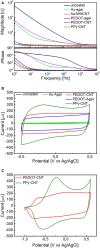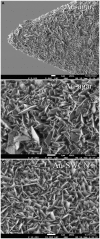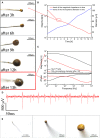Smaller, softer, lower-impedance electrodes for human neuroprosthesis: a pragmatic approach
- PMID: 24795621
- PMCID: PMC3997015
- DOI: 10.3389/fneng.2014.00008
Smaller, softer, lower-impedance electrodes for human neuroprosthesis: a pragmatic approach
Abstract
Finding the most appropriate technology for building electrodes to be used for long term implants in humans is a challenging issue. What are the most appropriate technologies? How could one achieve robustness, stability, compatibility, efficacy, and versatility, for both recording and stimulation? There are no easy answers to these questions as even the most fundamental and apparently obvious factors to be taken into account, such as the necessary mechanical, electrical and biological properties, and their interplay, are under debate. We present here our approach along three fundamental parallel pathways: we reduced electrode invasiveness and size without impairing signal-to-noise ratio, we increased electrode active surface area by depositing nanostructured materials, and we protected the brain from direct contact with the electrode without compromising performance. Altogether, these results converge toward high-resolution ECoG arrays that are soft and adaptable to cortical folds, and have been proven to provide high spatial and temporal resolution. This method provides a piece of work which, in our view, makes several steps ahead in bringing such novel devices into clinical settings, opening new avenues in diagnostics of brain diseases, and neuroprosthetic applications.
Keywords: Intracortical microelectrodes; brain-conformability; carbon nanotubes; conductive polymers; hydrogel; micro-electrocorticography (ECoG); neural recording; neural stimulation.
Figures














Similar articles
-
PEDOT-CNT-Coated Low-Impedance, Ultra-Flexible, and Brain-Conformable Micro-ECoG Arrays.IEEE Trans Neural Syst Rehabil Eng. 2015 May;23(3):342-50. doi: 10.1109/TNSRE.2014.2342880. Epub 2014 Jul 25. IEEE Trans Neural Syst Rehabil Eng. 2015. PMID: 25073174
-
Recording human electrocorticographic (ECoG) signals for neuroscientific research and real-time functional cortical mapping.J Vis Exp. 2012 Jun 26;(64):3993. doi: 10.3791/3993. J Vis Exp. 2012. PMID: 22782131 Free PMC article.
-
Achieving Ultra-Conformability With Polyimide-Based ECoG Arrays.Annu Int Conf IEEE Eng Med Biol Soc. 2018 Jul;2018:4464-4467. doi: 10.1109/EMBC.2018.8513171. Annu Int Conf IEEE Eng Med Biol Soc. 2018. PMID: 30441342
-
Organic electrode coatings for next-generation neural interfaces.Front Neuroeng. 2014 May 27;7:15. doi: 10.3389/fneng.2014.00015. eCollection 2014. Front Neuroeng. 2014. PMID: 24904405 Free PMC article. Review.
-
Progress in the Field of Micro-Electrocorticography.Micromachines (Basel). 2019 Jan 17;10(1):62. doi: 10.3390/mi10010062. Micromachines (Basel). 2019. PMID: 30658503 Free PMC article. Review.
Cited by
-
Biocompatibility Testing of Liquid Metal as an Interconnection Material for Flexible Implant Technology.Nanomaterials (Basel). 2021 Nov 30;11(12):3251. doi: 10.3390/nano11123251. Nanomaterials (Basel). 2021. PMID: 34947600 Free PMC article.
-
Spectral Power in Marmoset Frontal Motor Cortex during Natural Locomotor Behavior.Cereb Cortex. 2021 Jan 5;31(2):1077-1089. doi: 10.1093/cercor/bhaa275. Cereb Cortex. 2021. PMID: 33068002 Free PMC article.
-
Cortical control of object-specific grasp relies on adjustments of both activity and effective connectivity: a common marmoset study.J Physiol. 2017 Dec 1;595(23):7203-7221. doi: 10.1113/JP274629. Epub 2017 Sep 2. J Physiol. 2017. PMID: 28791721 Free PMC article.
-
Advances in Carbon-Based Microfiber Electrodes for Neural Interfacing.Front Neurosci. 2021 Apr 12;15:658703. doi: 10.3389/fnins.2021.658703. eCollection 2021. Front Neurosci. 2021. PMID: 33912007 Free PMC article. Review.
-
Slippery Epidural ECoG Electrode for High-Performance Neural Recording and Interface.Biosensors (Basel). 2022 Nov 18;12(11):1044. doi: 10.3390/bios12111044. Biosensors (Basel). 2022. PMID: 36421162 Free PMC article.
References
-
- Abidian M. R., Martin D. C. (2009). Multifunctional nanobiomaterials for neural interfaces. Adv. Funct. Mater. 19, 573–585 10.1002/adfm.200801473 - DOI
LinkOut - more resources
Full Text Sources
Other Literature Sources

